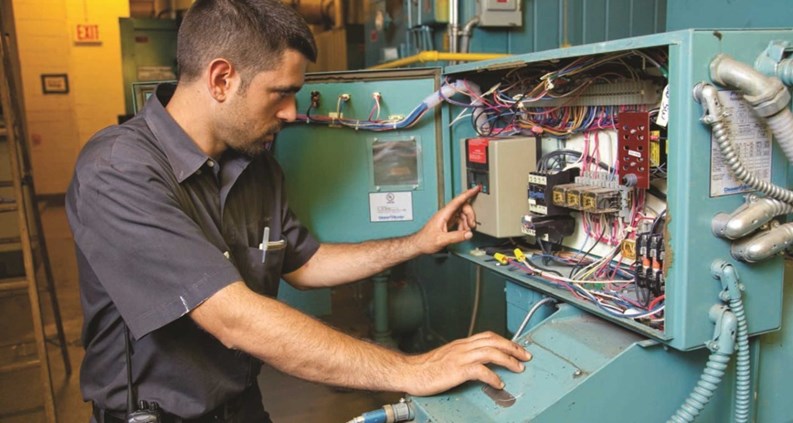There have long been organizations that strive to strengthen and clarify the roles of owners, residents, and managers within the cooperative housing environment. But one essential player in the game—the superintendent—was the last to find representation. Thanks to the work of the New York City Superintendents Technical Association (STA), the workhorses of the multifamily building have a voice, too.
Work Boots 'n' Club Roots
According to Peter Roach, STA’s current president, the group boasts a membership of about 150 “supers,” (up 15 percent from last year), and attendance at the non-profit group’s free meetings is strong, with around 40-45 seats filled each month. Thousands of superintendents across the city read Building to Building, STA’s bi-monthly trade publication. “We’re about to launch our new and improved website,” Roach adds. “It will contain more links to educational videos and resources, and it's more user friendly.”
They’re on Facebook and are hopping on Twitter, too. But it’s taken awhile to get here. The story begins with Dick Koral, director of the Apartment House Institute (AHI), New York City Technical College’s continuing education unit. In the late 1970s, Koral, an engineering technician and expert on energy conservation, operation, and maintenance in multifamily dwellings, began teaching a group of supers the basics of running a building. Many supers were recent immigrants and knew very little about boilers or plumbing. Koral knew this was because of a simple lack of experience and education, not a lack of intelligence.
With grant funding from the now-defunct New York State Energy Office, Koral created the Los Sures Supers Technical Association, or STA. The group met each week in Williamsburg and discussed (with the help of a translator) topics chosen by members. The grant ran out a year later, and the group disbanded, but the seeds of the original STA had been planted.
It was several years later, in 1998, that Koral founded the incarnation of the group that thrives today. Originally called The Supers Club, STA has grown steadily over the years with help from dedicated members who knew the concept, as well as the people involved, had great potential.
Your Friendly Neighborhood Super
One such member is Peter Grech, a super in the business for 31 years, past STA president and its current Director of Educational Services, and a member since 1998.
“The STA was and still is an education experiment parented and supported by City College of Technology School of Continuing Education,” he says, pointing out that the “experiment” won the Continuing Education Association of New York’s 2003 award for Exemplary Program in Non-Credit Program Development, a distinction that recognizes innovation. “It's one of my life’s best achievements,” Grech says of the growth of the STA; then, half-jokingly, “even though City College got all the credit!”
There is certainly credit due for an organization with such clear goals and strong mission. That mission, of course, has always been to provide building maintenance personnel, including superintendents, handymen, porters, doormen, and others in the trade a professional society that encourages these workers to share their expertise, educate themselves about their industry, and learn of new equipment and maintenance procedures. As a byproduct, STA encourages professionalism among its members and the industry as a whole; after all, where there is organization and representation, there’s usually an extra helping of dignity.
Considering all that a super has to contend with, it might surprise some that groups like STA—which includes in its mission statement the desire to help establish similar groups in other areas—has only been around since the late 1990s. Supers tackle the nitty-gritty, day-to-day maintenance of city buildings; mold, paint, asbestos, noise, water, leaky pipes, and minor plumbing issues are all in a day’s work.
Over the past 25 years or so however, the average super's responsibilities have grown far beyond those concerns. Certification laws, zoning issues, laws concerning building security, and green energy initiatives all impact a super’s job description. From a building’s fire escape plan to the bushes in the courtyard, the super is the right hand of the building's administrators; all of his (rarely her) work is under surveillance, too, with all the cameras and video recorders installed in most buildings these days. Even before the job became so complex—anyone text their super lately?—the STA’s job has been to protect and educate supers about the nature of their work.
How It Works, Where It’s Going
STA holds monthly meetings centered around various topics specific to New York building maintenance personnel. At these meetings, plans are hatched, networking can take place, and information is shared. Members also put their heads together about problems facing the group.
Grech says one of the biggest challenges facing the STA right now is finding executive committee members; there are currently two members doing “double duty.” He adds that membership, though up from last year, is always a priority. “We always seem to bring in enough new members to cover the members we lose,” he says, but growth is key. “We would like to have 400-plus members.”
There are other goals as well. Grech says STA is looking to expand their education program by introducing new classes but keeping them affordable for members and non-members. “Our five-year goal is to become New York City’s best resource for multifamily buildings,” Grech says, noting that they’ve answered somewhere around 1,400 questions from the public, proving they’re a strong contender for a go-to resource.
Grech isn’t surprised the STA is called upon so often. To him, the organization’s reach extends far beyond the industry in which its members work. “Our impact can’t be measured,” he says. “By helping supers and multifamily workers be better at what they do, it simply passes on to their job performance and filters down as better quality of life for residents. We have a charity work arm to help out people or organizations where we can—currently we’re helping a convent on the Upper East Side with some repairs and painting.” The group helps their members with such things, too. “In the past, we have helped supers who were overwhelmed by knocking out some odds-and-ends work at their building.”
The Group Today
In the middle of a deep recession, many professional organizations are feeling depleted. Membership flags, interest wanes as people shuffle priorities. But Grech says that the recession hasn’t hit the STA too hard. And instead of taking it lying down, the supers are reorganizing their goals.
“While our membership is slightly down, it is not down to any historic lows, surprisingly enough,” he says. “Our organizational role has shifted slightly in the direction in helping members find jobs. This seems to be the number one issue. We help our members building a quality resume by helping members do better at interviews and also help find jobs by passing on information to them.”
The STA is using social media and the web to their full advantage, as well. The group’s Facebook page is updated regularly with information about classes, seminars, free informational meetings and social events. On the STA website (www.nycsta.org), supers can find the organization’s bylaws, mission statement, press releases, and photo archives. There are links to major papers, weather reports, even book reviews and blogs written by supers.
The soon-to-be overhauled website is also a resource for troubleshooting: The frequently asked questions page is a clearinghouse for all manner of questions related to building maintenance profession, from people outside the industry; queries like: “The building I just moved into has a super, a handyman, 5 or 6 doormen, and 5 or 6 porters. Who do I tip and how much?” are common, as are questions from those already working in the profession or wanting to get into it, e.g., “I would like to know where can I get a sample of the boiler exam and in what location the exams are given.” Since membership cost is kept down with the help of vendor support, newsletter and online advertisers are given space on the STA website, and links to their business are provided.
As the super-sage Grech says, “The two lessons that I have learned over the past 38 years are that ‘no good deed goes unpunished’ and that while good intentions are fine, its action that counts.” Through the continued work of the STA, the latter is certainly being proven true.
Mary K. Fons is a freelance writer and a frequent contributor to The Cooperator.







Comments
Leave a Comment